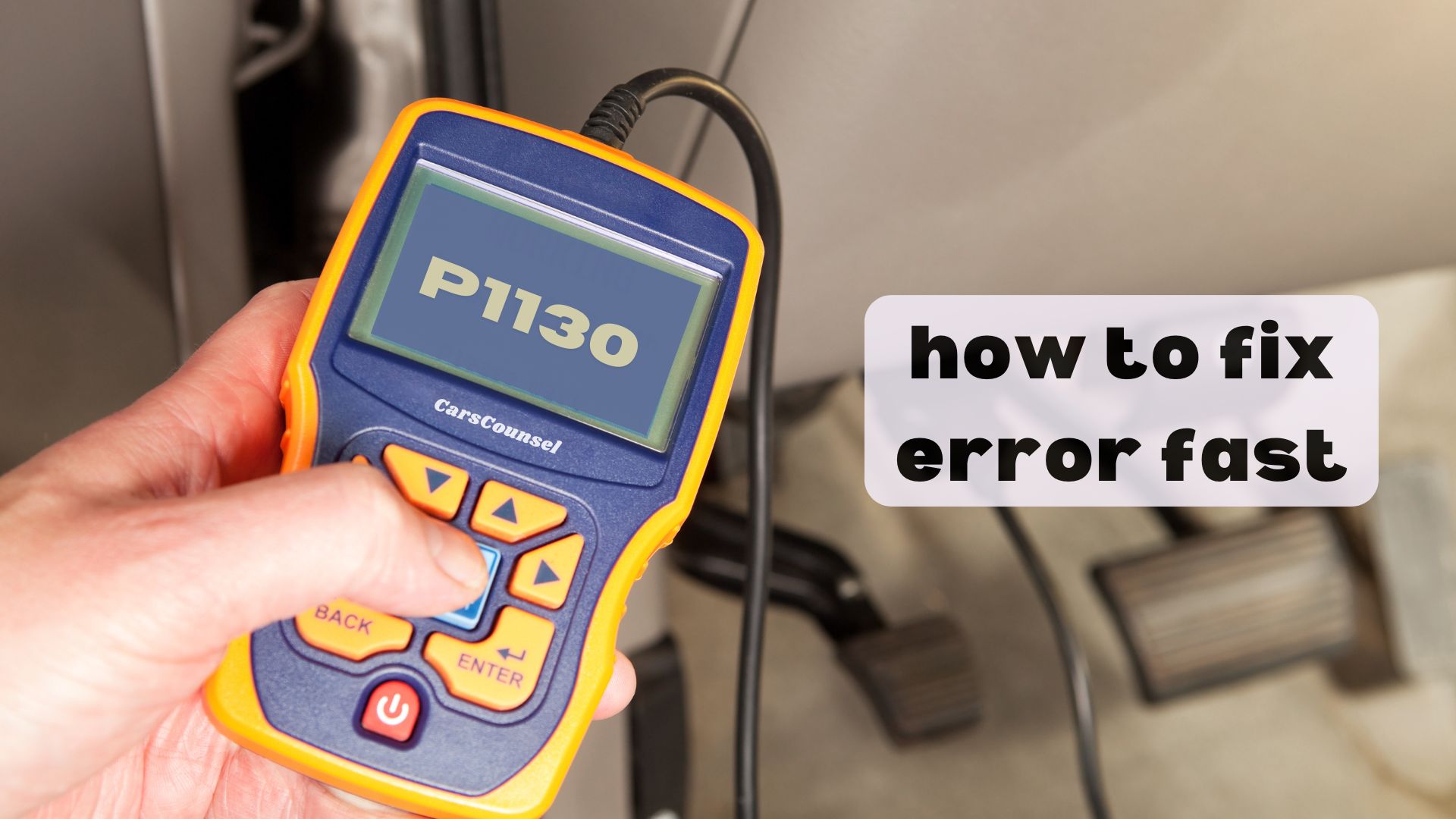Imagine you’re driving a Nissan Altima when the check engine light comes on, displaying the P1130 code. This code indicates a malfunction in the Swirl Control Valve Control Solenoid Valve, which regulates airflow in the engine. As you continue driving, you might notice decreased performance and poor fuel efficiency. Understanding the causes and symptoms of this code is vital for effective diagnosis and repair. What steps will you take next to address this issue?

Quick Navigation
Key Takeaways
- P1130 code indicates a problem with the Swirl Control Valve Control Solenoid Valve.
- It affects airflow regulation in the engine’s intake manifold.
- Symptoms include rough idling and decreased fuel efficiency.
- Causes include faulty solenoids, electrical issues, and mechanical problems.
- Repairs involve replacing the solenoid or inspecting electrical connections.
Understanding the P1130 Code
Understanding the P1130 Code involves recognizing it as a diagnostic trouble code that indicates a problem with the Swirl Control Valve Control Solenoid Valve.
This valve is significant for regulating airflow in the engine’s intake manifold, affecting combustion efficiency. The solenoid operation controls the swirl valve’s open and close functions, which are important for optimizing engine performance.
When the P1130 code appears, it suggests issues with solenoid operation or the swirl valve itself, potentially leading to decreased engine performance and efficiency.
Proper diagnosis is essential to address these problems effectively.
Common Causes of the P1130 Code
The P1130 code is triggered by several key issues affecting the Swirl Control Valve Control Solenoid Valve.
You’ll need to check for a faulty solenoid valve, which is essential for controlling the swirl control valve’s operation.
Electrical issues within the solenoid valve circuit can also cause this code.
Additionally, mechanical problems with the swirl control valve itself or sensor malfunctions can trigger the P1130 code.
Carbon buildup in the intake manifold may also contribute to the issue.
Identifying these causes will help you address the problem effectively.
Symptoms of the P1130 Code
When your vehicle’s engine control module (ECM) detects an issue with the Swirl Control Valve Control Solenoid Valve, it triggers the P1130 code.
This code can lead to noticeable symptoms affecting your vehicle’s operation. You may experience reduced engine performance, which can manifest as poor acceleration or rough idling.
Additionally, fuel efficiency may suffer, leading to increased fuel consumption. Other symptoms include an illuminated Check Engine Light and potential engine misfires or stalling.
These issues can compromise your vehicle’s overall performance and efficiency.
Diagnostic Process for P1130
To diagnose the P1130 code effectively, you’ll need to follow a systematic approach.
Start by using diagnostic tools to retrieve the trouble code and inspect related components.
Next, perform solenoid testing to guarantee the swirl control valve solenoid valve operates correctly.
Check for electrical faults in the solenoid valve circuit and inspect the swirl control valve for mechanical issues.
Use a multimeter to verify proper voltage and resistance readings.
Finally, clear the code and reset the engine control module after repairs.
Repairing the P1130 Code
Repairing the P1130 code involves a methodical process to address issues with the Swirl Control Valve Control Solenoid Valve.
You’ll need to inspect and potentially replace the solenoid valve to guarantee proper airflow regulation.
Key steps include:
- Inspecting the swirl valve for mechanical issues
- Conducting a solenoid replacement if necessary
- Checking electrical connections for faults
This process helps restore peak engine performance and efficiency by resolving issues related to the swirl valve and solenoid operation.
Cost Considerations for Repair
The cost of fixing a P1130 code can vary significantly depending on the specific needs of your vehicle.
When planning your repair budget, consider that parts pricing typically ranges from $100 to $300. Labor costs can also vary, often falling within the same range.
This means your total repair costs could be between $200 and $600. Factors influencing these costs include the make and model of your vehicle, as well as the extent of the necessary repairs.
Make certain you factor in all these elements to accurately estimate your repair expenses.
Prevention and Maintenance Tips
After considering the costs associated with fixing a P1130 code, it’s clear that proactive maintenance can help prevent such issues.
Regular swirl valve maintenance is essential for maintaining peak engine performance.
Here are some key tips:
- Inspect Electrical Connections: Confirm all wiring to the swirl control valve solenoid is secure and free from corrosion.
- Clean Intake Manifold: Regularly clean the intake manifold to prevent carbon buildup.
- Monitor Engine Performance: Keep an eye on your engine’s performance to catch any issues early.
Potential Risks of Ignoring the P1130 Code
Ignoring the P1130 code can lead to significant risks for your vehicle’s engine performance and longevity.
If left unaddressed, it may cause decreased engine performance, poor fuel efficiency, and potential damage to engine components.
Delaying repairs can extend the repair timeline, leading to more costly fixes.
It’s essential to address the issue promptly to prevent further complications and guarantee peak engine operation.
More OBD-II Codes
| P1132 | P1133 | P1134 | P1136 |
| P1135 | P1147 | P1148 | P1149 |
| P1150 | P1032 | P1153 | P1154 |
| P1336 | P1352 | P1361 | P1362 |
| P1380 | P1381 | P1404 | P1441 |
| P1546 | P1641 | P1651 | P1652 |
Frequently Asked Questions
Can I Drive With the P1130 Code?
You can drive with the P1130 code, but it may compromise driving safety and engine performance. Reduced efficiency and power could lead to stalling or misfires, so addressing the issue is advisable.
Is the P1130 Code Specific to Nissan?
Like a puzzle piece, the P1130 code fits into Nissan diagnostics, specifically concerning the Swirl valve. It’s not exclusive to Nissan, as similar codes appear in other vehicles, but it’s commonly associated with Nissan’s Swirl valve issues.
Does the P1130 Affect Engine Longevity?
You may experience engine wear if the P1130 issue isn’t addressed, as poor valve performance can lead to inefficient combustion, potentially reducing engine longevity.
Can I Fix P1130 Without Professional Help?
While professional assistance is ideal, you can attempt DIY repairs by employing troubleshooting techniques to diagnose and potentially fix issues like faulty solenoids or wiring, though caution is advised due to complexity.
Will Clearing the Code Fix the Issue?
You can’t fix the issue by just clearing the code. Use diagnostic tools to identify the root cause, then address it. Clearing the code will only temporarily remove the warning until the problem recurs.
Conclusion
Fixing the P1130 code is like solving a puzzle—each piece must fit perfectly to restore engine performance. By addressing faulty solenoids, wiring issues, or mechanical problems, you can prevent decreased fuel efficiency and poor acceleration. Ignoring this code can lead to engine damage, so it’s essential to diagnose and repair it promptly. Regular maintenance can help prevent such issues, ensuring your vehicle runs smoothly and efficiently.

